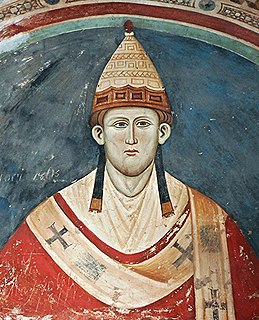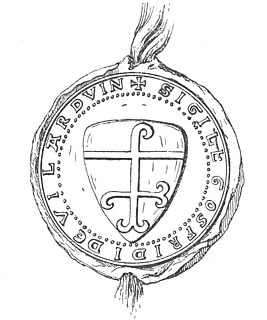
Pope Innocent III, born Lotario dei Conti di Segni, was the head of the Catholic Church and ruler of the Papal States from 8 January 1198 to his death in 16 July 1216.

Theodore I Laskaris or Lascaris was the first emperor of Nicaea—a successor state of the Byzantine Empire—from 1205 to his death. Although he was born to an obscure aristocratic family, his mother was related to the imperial Komnenos clan. He married Anna, a younger daughter of Emperor Alexios III Angelos in 1200. He received the title of despot before 1203, demonstrating his right to succeed his father-in-law on the throne.

Henry was the second Latin emperor of Constantinople. He was one of the leaders of the Fourth Crusade in which the Byzantine Empire was conquered and Latin Empire formed.

The Latin Empire, also referred to as the Latin Empire of Constantinople, was a feudal Crusader state founded by the leaders of the Fourth Crusade on lands captured from the Byzantine Empire. The Latin Empire was intended to replace the Byzantine Empire as the Western-recognized Roman Empire in the east, with a Catholic emperor enthroned in place of the Eastern Orthodox Roman emperors.

Kaloyan or Kalojan, also known by his Vlach name Johannitsa or Ioannitsa, was Tsar of Bulgaria from 1196 to 1207. He was a younger brother of Theodor and Asen who led the anti-Byzantine uprising of the Bulgarians and Vlachs in 1185. The uprising ended with the restoration of the independence of Bulgaria. He spent years as a hostage in Constantinople in the late 1180s. Theodor made him his co-ruler after Asen was murdered in 1196. A year later, Theodor-Peter was also assassinated, and Kaloyan became the sole ruler of Bulgaria.
Bohemond IV of Antioch, also known as Bohemond the One-Eyed, was Count of Tripoli from 1187 to 1233, and Prince of Antioch from 1201 to 1216 and from 1219 to 1233. He was the younger son of Bohemond III of Antioch. The dying Raymond III of Tripoli offered his county to Bohemond's elder brother, Raymond, but their father sent Bohemond to Tripoli in late 1187. Saladin, the Ayyubid sultan of Egypt and Syria, conquered the county, save for the capital and two fortresses, in summer 1188.

Geoffrey I of Villehardouin was a French knight from the County of Champagne who joined the Fourth Crusade. He participated in the conquest of the Peloponnese and became the second prince of Achaea.
Pelagio Galvani was a Leonese cardinal, and canon lawyer. He became a papal legate and leader of the Fifth Crusade.

Peter of Capua was an Italian scholastic theologian and prelate. He served as cardinal-deacon of Santa Maria in Via Lata from 1193 until 1201 and cardinal-priest of San Marcello al Corso from 1201 until his death. He often worked as a papal legate. He wrote several theological works and was a patron of his hometown of Amalfi.
Sicardus of Cremona (1155–1215) was an Italian prelate, historian and writer.
Ottaviano di Poli, a member of the family of the Counts of Poli, was an Italian Roman Catholic Cardinal.
Nicholas Mesarites was a Byzantine Greek churchman and writer, who eventually rose to the office of Metropolitan of Ephesus in the Empire of Nicaea.
Berthold II von Katzenelnbogen was a German nobleman of the family of the Counts of Katzenelnbogen and a participant in the Fourth Crusade (1202–04), who became lord of Velestino (c.1205–17) and regent of the Kingdom of Thessalonica (c.1217) in Frankish Greece. He was a patron of poets and in politics a Ghibelline.

John was a prelate in the Kingdom of Hungary in the 12th and 13th centuries. He was Bishop of Csanád between 1198 and 1201, Archbishop of Kalocsa from 1202 to 1205 and Archbishop of Esztergom between 1205 and 1223. He crowned Ladislaus III of Hungary, Andrew II of Hungary and Coloman of Halych king. Andrew II appointed him to govern the kingdom during his crusade between 1217 and 1218.
Soffredo was an Italian cardinal. His name is also given as Soffredo Errico Gaetani, whilst his Christian name is also spelled Soffrido or Goffredo in some sources.
Eustace of Flanders or Eustace of Hainaut was a member of the House of Flanders, brother of the Latin Emperors Baldwin I and Henry, and regent of the Kingdom of Thessalonica in 1209–1216.

Peter was an Italian Cistercian monk and prelate. He was the abbot of Rivalta from 1180 until 1185, abbot of Lucedio from 1185 until 1205, abbot of La Ferté from 1205 until 1206, bishop of Ivrea from 1206 until 1208 and patriarch of Antioch from 1209 until his death. He is known as Peter of Magnano, Peter of Lucedio or Peter of Ivrea.
The timeline of the Latin Empire is a chronological list of events of the history of the Latin Empire—the crusader state that developed on the ruins of the Byzantine Empire after the Fourth Crusade in the 13th century.
Gerardo da Sesso was an Italian monk, bishop and cardinal of the Catholic Church.